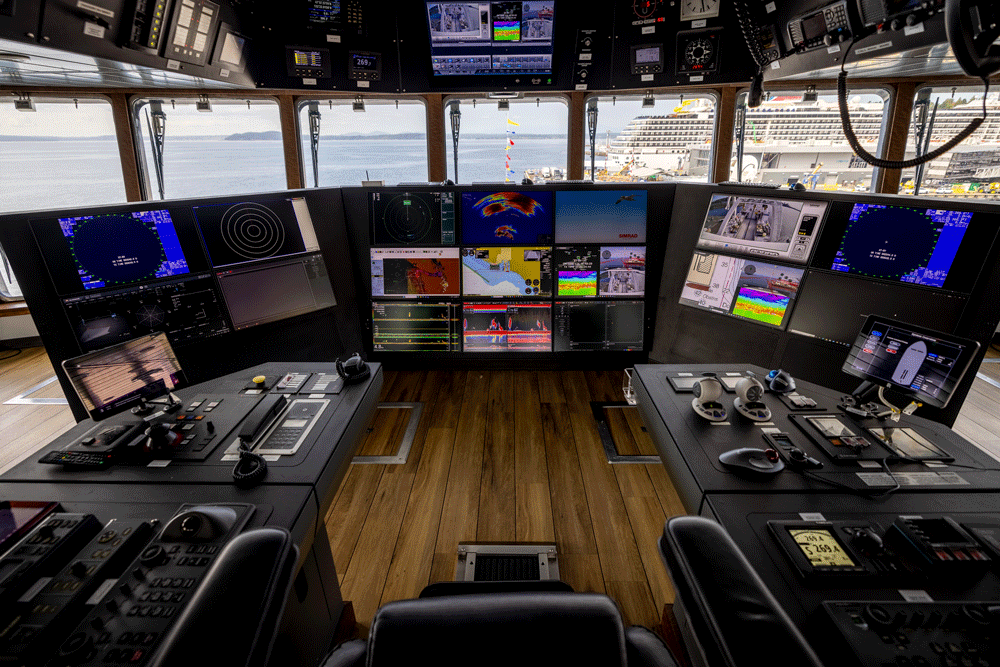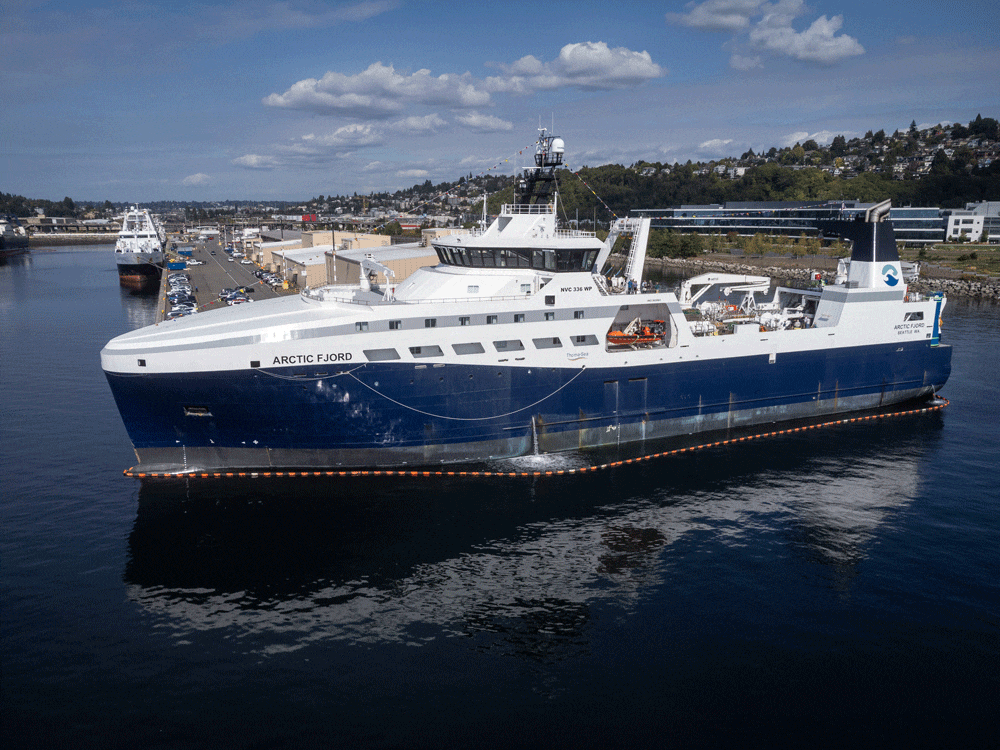Seattle-based fishery Arctic Storm Management is replacing its 83m, 1974-built trawler Arctic Fjord with a larger newbuild of the same name – and one specifically designed to handle operations in the Bering Sea, where 45knot winds, 4m wave heights and heavy snowfall in coastal areas are not unknown.
The 99m x 21m newcomer was constructed domestically, in line with the Jones Act, by Louisiana-based boatyard Thoma-Sea, and to the specs of the NVC 336 WP trawler design, supplied by Norway’s Kongsberg Maritime. In fact, this order ranks as Kongsberg’s first ever contract for a US-built vessel, as well as one of the largest fishing vessels the group has designed to date.
“We first entered discussions with Thoma-Sea in 2016,” Einar Vegsund, director for Kongsberg’s Ship Design Solutions division, tells Ship & Boat International. The contract was then signed in 2018, giving Kongsberg optimal time to assess the design requirements for operations in this new territory, and to plan the vessel accordingly – necessitating compliance with US Coast Guard stipulations, for example. Vegsund recalls: “Arctic Fjord is designed for a 152-man crew, which meant installing 48 cabins – whereas 25-28 cabins is more typical for Norwegian fillet trawlers.” The vessel was also ice-classed, to handle the Bering Sea’s harsh winters, and designed to feature a scantling draught of 8.5m.
The newbuild was then delayed by the COVID-19 pandemic and its accompanying restrictions – and then, in August/September 2021, by Hurricane Ida, which knocked out the power at the Thoma-Sea facility for over a month, while causing extensive disruption and damage to the yard’s home town of Houma. However, after a long wait, the MkII Arctic Fjord is now stationed in Seattle and ready to commence operations next year – and is described by Arctic Storm as “the first new vessel for the wild Alaska pollock catcher/processor fleet to be built in the US in over 30 years”. The trawler will process surimi, fillet, fish meal and fish oil for a global market, with all phases of the process being handled on board.
Arctic Fjord features a wave-piercing bow, to reduce both fuel consumption and slamming in rough waters, Vegsund explains, adding: “The vessel has been designed for trawling, so there was a high pull requirement.” This is enabled by a single 7,200kW Bergen B33-45V12P main engine, powerful enough to grant the vessel a bollard pull of 110tonnes. When the newbuild made its way from the Gulf of Mexico to Seattle for handover, it did so at an average speed of 16.4knots, though subsequent sea trials off the US West Coast have seen the vessel exceed 19knots – notably fast, given its size.
The trawer can store approximately 4,000m3 of fish products, 1,260m3 of fish meal and 490m3 of fish oil. Other tank capacities include 1,050m3 of marine fuel oil and 180m3 of potable water. Arctic Fjord has a freezing capacity of 250tonnes per day – roughly twice the volume handled by its previous namesake. The onboard fish-processing factory was supplied by Danish company Carsoe, while Swan Net USA provided the boat’s trawl gear.

The trawler’s bridge has been likened to a “Microsoft operations centre” (image: Arctic Storm Management)
Other installations include a Bergen auxiliary engine (rated 3,600kW) and a 1,050kW Kongsberg TT 1850 tunnel thruster for enhanced manoeuvrability. As is often the case with its contracts, Kongsberg oversaw the supply of the vessel’s main electrics and propulsive set-up, including the gearbox and propeller, plus a sonar-enabled fish-finding system and pump/valve/tank controls, and will provide ongoing system support to the owner. Additionally, the vessel incorporates Kongsberg’s ‘Take Me Home’ system, which can reroute power from the auxiliary engine to the propeller, should the main engine run into difficulties. The vessel also hosts a pair of 650kW refrigerated sea water (RSW) units.
Arctic Fjord‘s array of deck machinery includes: four cranes; a pair of 73tonne trawl winches; four 45tonne net drums; two 26tonne windlass/mooring winches; two 50tonne Gilson winches; an 18tonne outhaul winch; and an 8tonne capstan. The vessel also carries a rescue boat, sized approximately 6.5m, to recover any man overboard casualties. For the crew’s comfort, all 48 cabins come with WC/shower facilities, and Wi-Fi and Internet Protocol Television (IPTV) are provided throughout. The trawler also offers a hospital section, a galley and lounge areas. Arctic Fjord’s bridge meanwhile, has been described by one party as “like walking into a Microsoft operations centre”, with the modular consoles’ controls and screens ergonomically arranged for ease of use. On deck, the vessel’s covered, sloped bow is intended to protect crew from the elements.
Given Arctic Storm’s statement of intent, we may well see further upgrades to its fleet, although nothing is confirmed as yet. Having passed this milestone, Vegsund says that Kongsberg would be interested in further US-based projects, which would give the company the chance to export some of the experience it has built up through its designs for European fisheries.






